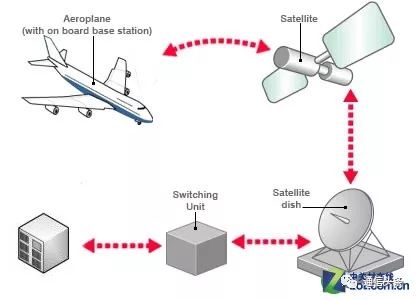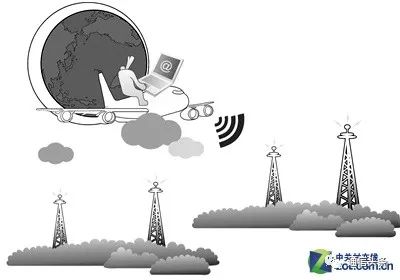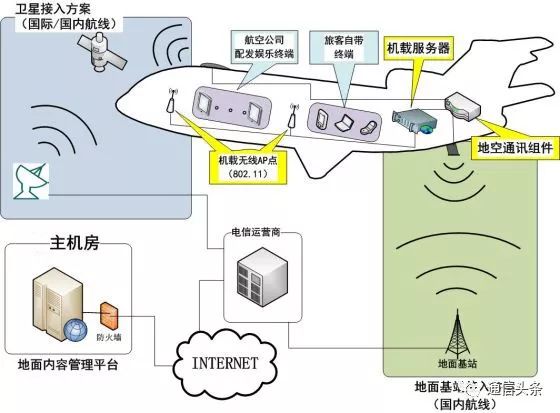Before interpreting the principle of high-altitude Internet access, let's review the early high-altitude Internet (aviation Internet) services. As early as 2005, Airbus Europe announced the launch of the world's first cabin "wireless (WiFi) network system", which uses the "Global Star" satellite communication system to achieve high-altitude Internet access. In 2007, the world's first CDMA-based ground-to-air broadband system was also introduced. It used the ground base station signal to cover high-altitude routes, thereby providing CDMA EVDO wireless access data bandwidth to the aircraft in flight to achieve high-altitude Internet access. . According to the relevant regulations of the Civil Aviation Administration of China on the use of portable electronic devices (PEDs), air passengers can use mobile phones on airplanes starting from 0:00 on January 18th, Beijing time. So, what is the principle of high-altitude WiFi Internet access? Let’s take it easy. Today, satellite-based and terrestrial-based base stations are still the primary means of achieving high-altitude Internet access today. Specifically, one is to implement ground-to-air communication by satellite, and the other is to implement ground-to-air broadband communication based on ATG (air to ground). Among them, the method based on satellite communication is very well understood, that is, the use of satellite, aircraft, satellite ground stations for data communication, its advantage is a wide range of communications, can achieve international roaming (of course, taking into account the frequency of countries, international flights The route can not achieve the same frequency coverage of the full range, and the signal delay or interruption is easy to switch when the signal is switched. Therefore, it is especially suitable for international routes; but its shortcomings are also obvious - only narrowband service can be provided, and the communication bandwidth is only 864Kbps, usually It can only provide simple Internet application services such as sending and receiving emails and web browsing on the aircraft. However, there have been some good news recently. The US Airways Corporation is in further cooperation with satellite giant Inmarsat, and plans to launch a global high-speed (GX) aviation network, which is expected to achieve broadband communication with a network speed of 50Mbps. The ground-to-air broadband communication based on ATG (ground base station mode) is slightly complicated in the initial construction. It needs to set up ground base stations along the flight route or specific airspace to cover the upper air, that is, use these ground base stations to directly carry information with the aircraft. transmission. Since the birth of ATG, 3G technology has been introduced, so ATG is regarded as ground-to-air broadband communication - its downlink bandwidth can reach 3.6Mbps, and the uplink bandwidth can reach 1.8Mbps. The Internet experience is obviously due to satellite communication. Of course, this type of communication itself has its own limitations—that is, it is necessary to deploy ground base stations, which are difficult to deploy across countries. Therefore, this communication method is not suitable for transoceanic (international routes), and is more suitable for large-scale land areas. country. For example, 1,500 flights from nine US airlines have used this communication method to achieve a comprehensive airborne Internet experience. Interpretation of the principle of surfing at high altitude After understanding the two basic communication access methods, let's take a look at how high-altitude Internet access is achieved. As shown in the above figure, no matter which communication access method is used, for passengers sitting in the aircraft, WiFi is provided through the aircraft to achieve high-altitude Internet access. Behind this, the most core equipment is the ground-to-air communication component, which realizes the interconnection and intercommunication with the data centers of telecom operators and service providers, and is the key to the successful access of the Internet to the Internet. At the same time, the onboard server + airborne wireless AP hotspots constitute the wireless LAN inside the aircraft, providing users with a WiFi Internet environment. Innovative ATG broadband communication based on 4G LTE Different from ATG ground-to-air broadband communication based on CDMA EVDO (3G) technology in the United States, China's ATG ground-to-air broadband communication adopts more advanced 4G LTE technology, and erects ground along flight routes or specific airspace through customized wireless transceiver equipment. Base station, and coverage to high altitude, can provide more than 100Mbps (theoretical) wireless data bandwidth for aircraft of different altitude routes, compared to the theoretical value of CDMA EVDO (downstream bandwidth 3.6Mbps, uplink bandwidth 1.8Mbps), higher than the number ten times! Of course, 100Mbps is only a theoretical value, which is still difficult to reach on the ground (the ground 4G is about 40-70Mbps). The challenge in the air is even greater, because the aircraft is flying at a high speed of 10,000 meters, and the speed is generally 700. -1000km, so it is necessary to solve the coverage and access problems of 4G LTE under such specific conditions, and also solve the problems of Doppler frequency offset caused by high-speed flight and high-speed handover of ground base station information. Fortunately, under the joint efforts of many parties (airline, 4G LTE equipment providers, telecom operators, etc.), the bandwidth of China's civil aviation ATG ground-to-air broadband communication can reach 15-30Mbps (upstream + downlink). I believe that I have seen the above introduction, and everyone has a more detailed understanding of the principle of high-altitude Internet access and the access technology behind it. What do you think, please leave a message? Tn Panel,Tn Lcd Display Module,Tn Positive Lcd Display Module,Tn Lcd Display Module Connector Huangshan Kaichi Technology Co.,Ltd , https://www.kaichitech.com
Realizing ground-to-air communication by satellite 
Ground-to-air broadband communication based on ATG (air to ground ground station method) 
The principle of high-altitude Internet access (picture from sootoo.com)